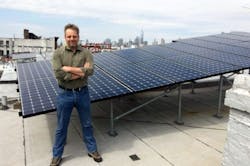NY Company to Bring Brooklyn Microgrid Peer-to-Peer Trading to Australia
Sophie Vorrath, of One Step Off the Grid, describes plans by LO3 Energy to bring Brooklyn Microgrid blockchain technology to Australia.
One of the architects of the peer-to-peer energy trading platform behind the world-leading Brooklyn Microgrid in the US has set up an office in New South Wales, with plans to trial its “TransActive Grid” technology in Australia.
Lawrence Orsini, founder of LO3 Energy, the company that funds the Brooklyn Microgrid project, has set up office in Australia. Image courtesy of Sasha Santiago
LO3 Energy opened an office in Byron Bay on Monday, as part of a global rollout of demonstration microgrid sites based on its proven peer-to-peer trading platform. It will be headed up in Australia by former environmental finance professional Belinda Kinkead.
The Brooklyn-based company, founded by Lawrence Orsini in 2012, has cut its teeth working to circumvent New York City’s power networks, to localise – and democratise – the supply of electricity to the City’s residents.
LO3’s TransActive Grid has been one of the pioneers of using Blockchain technology – originally used to run the bitcoin currency – to count up and log every unit of energy created by distributed energy systems such as rooftop solar or small-scale wind.
Software called ‘Smart Contracts’ then makes those units of energy available on the open market to be bought and sold in the local community.
Users can specify their energy requirements – choosing exactly where they buy from – or to make things even simpler, the process can be automated through a hands-off self-securing, ‘set and forget’ control system.
The technology has been successfully demonstrated through a project called Brooklyn Microgrid, in which Orsini and his team have installed infrastructure to enable a small network of Park Slope buildings, and another cluster in neighbouring Gowanus, to distribute locally sourced electricity – mostly rooftop solar – independently to the utility.
As reported in the Scientific American, the Brooklyn Microgrid’s short-term goal was to operate as a backup option during storms, cyber attacks and other catastrophic disruptions. But in the long term the infrastructure LO3 installs aims to set consumers on a path to fully owning the electricity their community generates, giving them a say in how to distribute it and possibly encouraging further investment in renewable energy sources.
Some of LO3’s most valuable experience, however, has come from working with regulators to overcome significant challenges to enable the Brooklyn Microgrid to function financially.
In Australia, where outdated regulations and policy settings have largely frustrated efforts at community energy sharing and distribution, Kinkead and her team plan to use that experience to achieving similar solutions.
“The Brooklyn Microgrid was only made possible because of progressive changes in policy and the engagement of the progressive utility companies,” Kinkead said in a statement on Monday.
“The LO3 teams in America and Europe have seen that forward thinking policy makers and energy companies are beginning to understand the opportunity that awaits.
“We hope that we can achieve similar cut-through in the Australian market as we believe we can develop the TransActive Grid to offer a win-win situation for energy regulators, consumers and producers large and small.”
In Australia, Kinkead says the plan is not to compete with the major utilities, but to partner with them to develop and prove the technologies and then integrate the peer-to-peer trading network naturally into the market.
“This is an exciting time in energy,” said Kinkead in a statement on Monday. “With the winding back of solar feed-in tariffs in many states, LO3 Energy’s Transactive Grid could enable producers to sell excess electricity to their neighbours at a more attractive rate for both sides – a real win-win. They will be able to buy and sell energy on their terms with more choices – that’s very interesting for people.”
“Also, as more and more and people install batteries, this technology offers an incentive for producers to stay on the grid, opening up new business models for utilities and distribution companies as well.”
And while LO3 is certainly not the only company looking to develop peer-to-peer energy trading in Australia – Perth-based start-up Power Ledger began conducting its own P2P trials in August of this year – it arrives here with the advantage of having already delivered proof of concept in America.
“We are now in a period of rapid global growth and are already in discussions with utilities across Europe and the Americas,” Kinkead said.
“We are now in a good position to take this forward and expect things to move fast, with the aim of announcing test projects running in the Australian market within the next few months.
LO3 CEO Orsini says the company’s technology has attracted “significant interest” from both consumers and major energy players, who “know they need to adapt to stay alive in a rapidly changing industry,” he said.
“This is a necessary evolution to the energy markets. People want more choice in where and who they get energy from – and buying energy from neighbours or your community is surely the best way to do it.
“We are now discussing demonstration projects with some of the biggest energy brands on the planet and look forward to working with the key players in the Australian energy industry to develop this opportunity.”
This article was originally published by Australia-based One Step Off the Grid and is reposted here with permission. Author Sophie Vorrath is deputy editor of One Step Off the Grid.
About the Author
Elisa Wood
Editor-in-Chief
Elisa Wood is the editor and founder of EnergyChangemakers.com. She is co-founder and former editor of Microgrid Knowledge.
